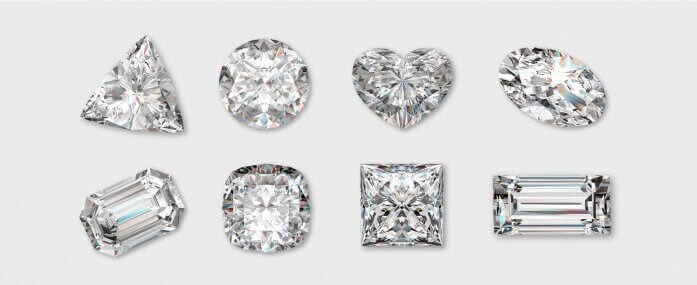
There are many factors to consider when choosing a diamond, with shape being one of them. When most people think of diamonds, they think of a classic round. While that’s the most popular shape (with around 70% of diamonds sold being round), there are many other shapes available to suit every personality type and taste preference.
As a note before diving into the most popular diamond shapes, the terms “shape” and “cut” represent two completely separate things. Many jewelers and consumers often use these terms interchangeably, thinking it refers to the same thing.
Shape refers to the geometrical outline of the diamond– round, emerald, cushion, and so on. Cut refers to how well an individual diamond’s facets are proportioned and finished.
Another term to keep in mind when looking at diamond shapes, is a “fancy shape”. Despite the exclusive-sounding name, fancy diamond cuts simply refer to all diamond shapes except for round diamonds.
Round | Princess | Cushion | Emerald | Oval | Pear | Radiant | Marquise | Asscher | Heart
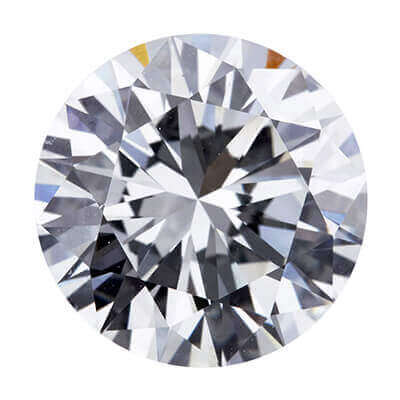
A timeless silhouette flattering on most hand shapes, round diamonds are popular for good reason- they show the best overall fire and brilliance. The faceting pattern of a round brilliant is optimized for sparkle and fire, featuring 57 or 58 facets. Through research and careful mathematical calculations, modern round diamonds are cut to feature excellent dispersion of light. When all 4Cs factors are equal, round diamonds are more valuable than any of their fancy shape counterparts.
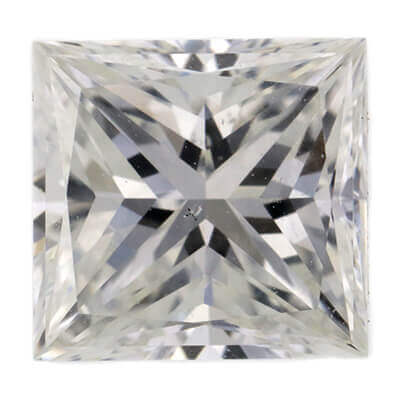
A contemporary cut introduced in the United States in 1980, princess cut diamonds are square with four distinct 90-degree corners. Princess diamonds are brilliant cut and have facets which are arranged in a similar manner to round diamonds for maximum sparkle. The most ideal princess diamonds are perfectly square in shape, with more rectangular variations decreasing in value.
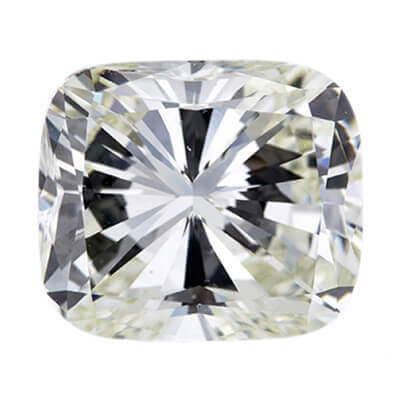
This classic cut has been around since the early 1800s and is also known as a pillow cut. Cushion cut diamonds have broad facets with rounded corners and sides and are available in square or rectangular silhouettes. For the first century of its existence, the cushion cut was the most popular diamond shape (similar to the modern round cut today). Older cushion cuts have a more subtle sparkle compared to a modern cushion cut, and both are popular in vintage-style rings.

Emerald cut diamonds are rectangular in shape with beveled corners. The pavilion–the lower half of the diamond–is made of successive parallel broad flat facets known as the step cut, as they resemble stair steps. It is a remarkably elegant cut, though not as fiery or brilliant as round diamonds. As the large table (the biggest flat facet on the top of the stone) accentuates the stone very clearly, it is best for diamonds with higher color and little to no inclusions, as those are more pronounced in this particular cut.
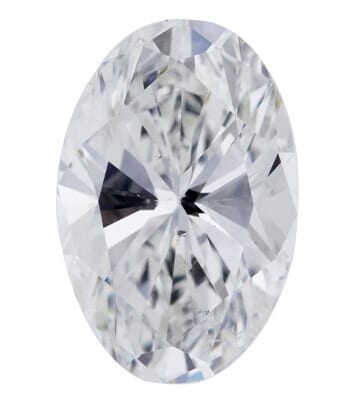
The modern oval cut follows a cutting style similar to the round brilliant cut and possesses similar fire and brilliance. The facets are stretched out, maximizing the look of its carat weight. This elongated cut creates the illusion of greater size when compared to round diamonds with the same carat weight. As a result, this stretched out stone shape is flattering on smaller hands as it lengthens the look of one’s fingers.
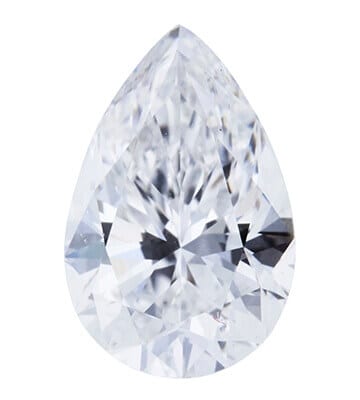
Resembling a drop of crystallized water, with a rounded end and a tapered point on the other; the pear cut is a hybrid of the round brilliant and the marquise. It is a cut rich in heritage, created in the 1400s by Lodewyk van Berquem, a renowned diamond cutter in Belgium. Like marquises and ovals, pear shape diamonds have an elongating effect when worn in a north-south orientation.
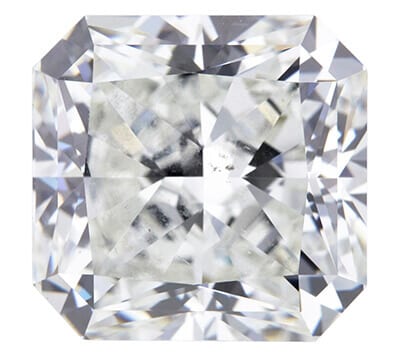
A recent cut invented in the 1970s, radiant cut diamonds are a hybrid between round and princess cut diamonds. They can be rectangular or more square, with distinct trimmed corners. This shape is focused on creating a more sparkly and brilliant diamond and has more facets than a round stone. Similar in silhouette to an emerald cut, radiant cut diamonds are more forgiving to inclusions and lower body color.
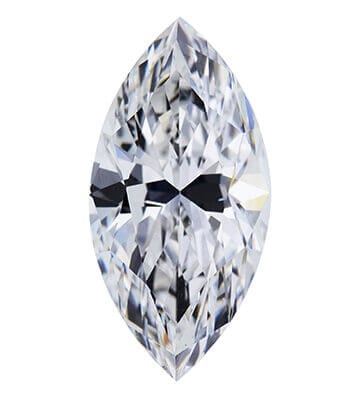
According to legend, the marquise was commissioned by King Louis XIV of France, to match the smile of his mistress, the Marquise de Pompadour. Similar to ovals, it is another stretched out shape, coming to two dramatic points on either end. Also called the navette (meaning “little ship”), this football-shaped cut has one of the largest surface area of any diamond shape, appearing bigger when compared to another diamond cut of equal carat weight.
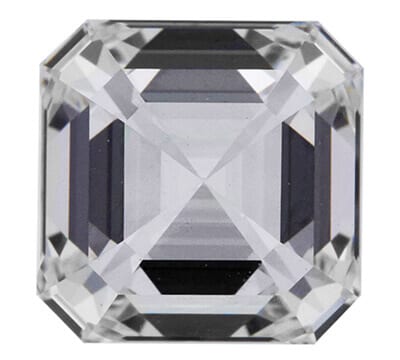
First introduced in 1902 by Joseph Asscher in Holland, the Asscher cut diamond is a step cut similar to the emerald cut. However, Asscher cut diamonds are cut in a perfect square with cropped corners, and a distinct “windmill” or X geometric pattern. A true Asscher cut diamond often looks like an octagon, with higher crowns (the top half of a diamond) and smaller tables when compared to emerald cut diamonds.
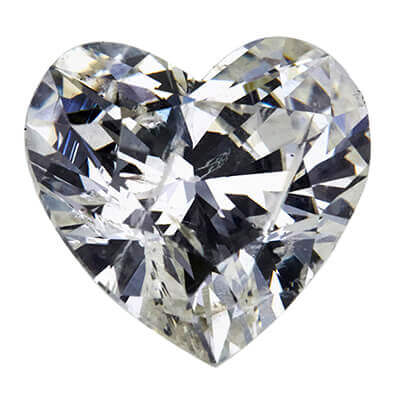
The heart-shape cut is a romantic one, as it is often associated with love and sentimentality. It is also a shape steeped in history, with the earliest mention dating back to the 1400s as a symbol of royalty. A modified brilliant cut, the heart shape is one of the most challenging shapes to cut, as it requires great skill and dexterity from the cutter.
Now that we’ve covered the ten most popular diamond shapes, we will delve into cut for our next follow up article. We’ll explore how cut can affect the look of each shape, and the ideal proportions to be mindful of when searching for the perfect stone.
©2011-2025 Worthy, Inc. All rights reserved.
Worthy, Inc. operates from 25 West 45th St., 2nd Floor, New York, NY 10036